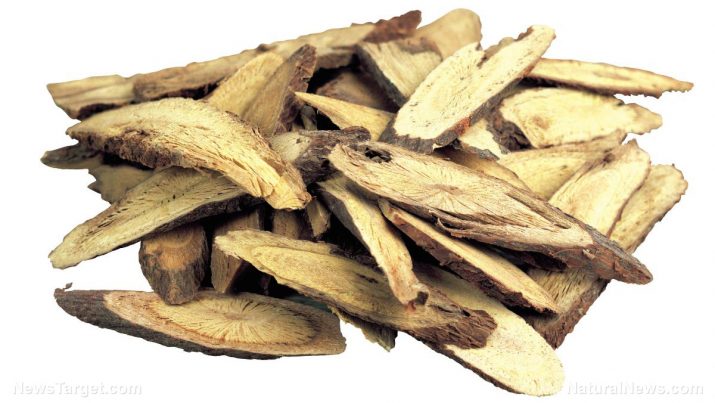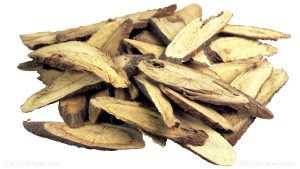
Licorice Root – sources, health benefits, nutrients, uses and constituents at NaturalPedia.com
Friday, June 23, 2017 by Russel Davis
http://www.naturalpedia.com/licorice-root-sources-health-benefits-nutrients-uses-and-constituents-at-naturalpedia-com.html

Licorice root is a widely known sweetener in candies and beverages. Aside from this, the popular flavoring has been used in traditional Chinese medicine for centuries as an additive to various herbal remedies. As a medicinal ingredient, licorice root is known to prevent a plethora of illnesses. Licorice root is derived from the Glycyrrhiza glabra plant, which belongs to the same plant family as peas.
List of known nutrients
Licorice root is notable for its high nutritional value. An article in LiveStrong.com has listed many of licorice root’s essential nutrients that promote the body’s overall health.
- Bioflavonoids
- Calcium
- Glycosides
- Isoflavonoids
- Phosphorus
- Tannins
- Terpenes
- Triterpenoids
Medicinal uses for licorice root
Licorice roots as best known for their digestive benefits, especially in relieving many intestinal conditions such as food poisoning, stomach ulcers, gastritis, and heartburn. The abundant flavonoid content in licorice root is found to ease discomfort and inflammation of the digestive system. The anti-inflammatory and immune-boosting properties of glycyrrhizic acid in licorice root are also found to accelerate the repair of the stomach’s lining as well as restore balance. In addition, previous studies show that the same compound can mitigate the growth and proliferation of the toxic bacteria H. pylori in the intestines.
Aside from this, licorice root may also promote bile production, which in turn regulate regulate the body’s cholesterol levels. Likewise, the rich antioxidant supply in licorice root is touted to promote capillary health and inhibit the onset of arterial plaque. The antioxidants in licorice root is found to inhibit the damage caused by bad cholesterol. On the other hand, the anti-inflammatory properties of licorice roots are known to protect and heal the liver. Licorice root is found to stave off the virus associated with the onset of hepatitis as well.
In addition, the phytoestrogens in licorice root contain mild estrogenic effect as well as anti-inflammatory and antispasmodic properties that may ease symptoms of premenstrual syndrome including irritability, bloating, and breast tenderness. Licorice root is also known to ease symptoms of menopause including exhaustion, mood swings, and hot flashes. On the other hand, the glycyrrhizin in licorice root may help boost energy, reduce stress, and alleviate symptoms of chronic fatigue syndrome and fibromyalgia. Additionally, licorice root is known to prevent the onset of breast cancer and prostate cancer.
Furthermore, the glycyrrhizic acid in licorice root is known to boost the function of adrenal glands, which in turn relieves nervousness and depression. Licorice root is also found to contain asparagine amino acid, an essential compound that maintains the equilibrium of the body’s nervous system. The herb is notably effective in addressing respiratory illnesses as well. Licorice root is found to loosen and thin mucus in the airways, which in turn helps the body eliminate phlegm. The herb is also known to bolster the body’s immune system, induce weight loss and promote skin health.
Body systems supported by licorice root
Licorice root is especially beneficial to the digestive system, as well as the respiratory and circulatory systems. The herb also supports the nervous, immune, and both the male and female reproductive systems.
Ways to use licorice root
As a popular sweetener, licorice root is incorporated in many desserts and baked goods. Licorice root can also be added to meat dishes and even light snack recipes. BBC.co.uk has curated many interesting licorice recipes across the web.
Where to learn more
- Licorice root proven effective against oral infections
- Licorice Root Extract: New Treatment for Canker Sores
- Licorice root extract proven to decrease liver enzymes
- Use licorice root to treat adrenal fatigue
- Licorice Root- Herb That Can Treat Depression, Constipation & Much More
Summary
Licorice root prevents digestive issues, respiratory conditions, and stress-related diseases.
Licorice root also staves off menstrual discomfort, cardiovascular diseases, and hepatitis.
Licorice root benefits the digestive, respiratory, and circulatory systems.
Licorice root supports the nervous, immune, and both the male and female reproductive systems.
Sources include:
Tagged Under: Tags: licorice root






